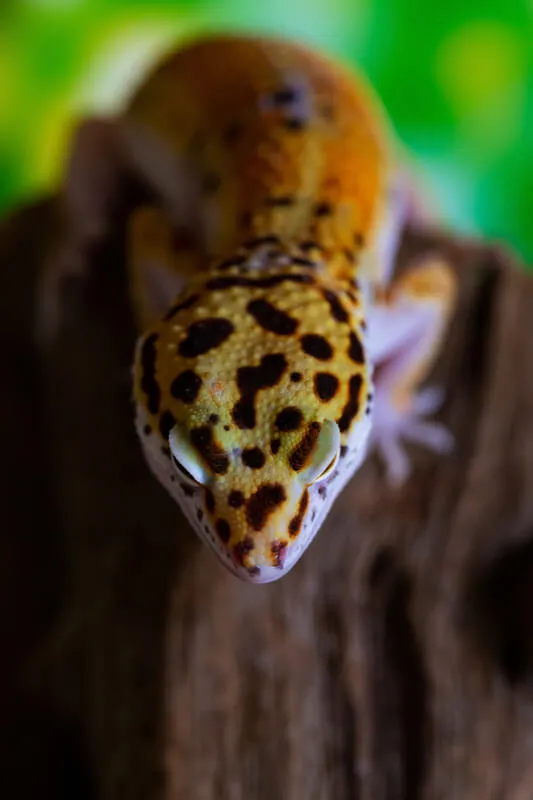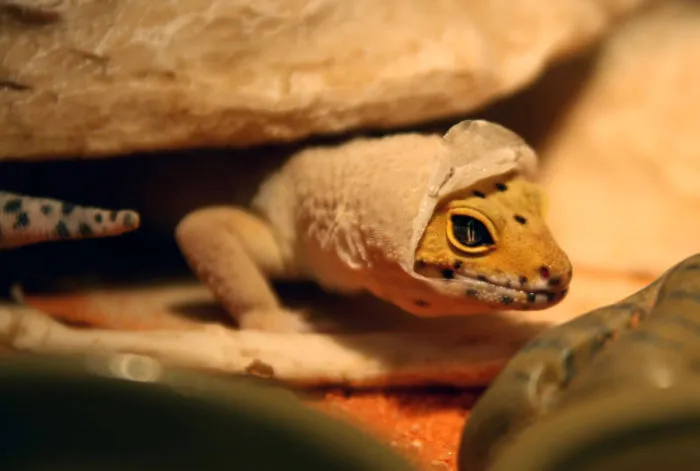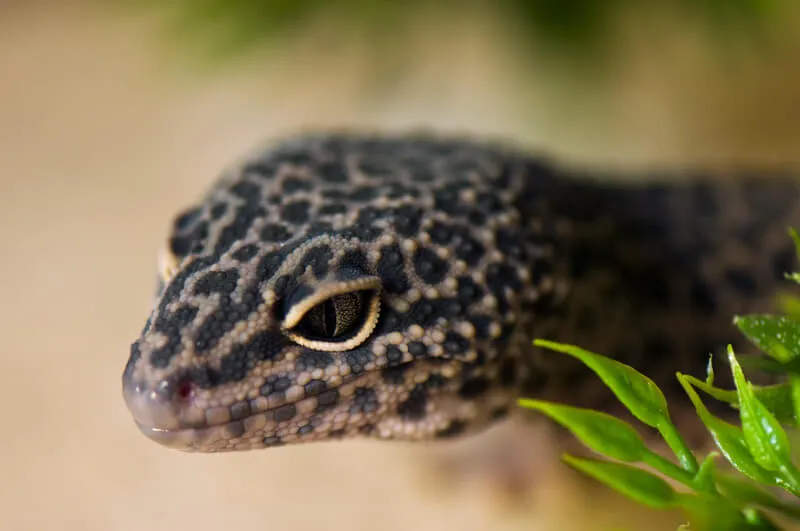
Curious about what happens when your leopard gecko gets stressed out? It can be a scary thing to see- after all, these cute little lizards are known for being calm, hardy little pets.
Not to worry, however. This article aims to show you how to cope. We will discuss fifteen different signs to look for if you suspect your leopard gecko is feeling stressed out. We will also offer some ways to keep your gecko feeling calm during these times.
What are some signs of stress in leopard geckos? Look for geckos acting skittish or aggressive when they are handled, waggling their tails, breathing quickly, spending lots of time in their hides, or looking dull in color. Other signs that you may recognize include glass surfing, or scratching at the glass, eating less than their usual amount of
These are some of the things to look for when caring for your leopard gecko.
Keep reading this article to see fifteen reasons as to why your leopard gecko is acting stressed, methods of helping them lower their stress level, and what you can do to prevent it from happening again in the future.
Table of Contents
Reason 1: Too Bright Lights
Ever got into your office or school on a drizzly gray day, and your head feels a bit off thanks to the fluorescent lights they use in the ceiling? Now you kind of have an idea about how it feels for the leopard gecko.
Leopard geckos are animals of the crepuscular species, meaning they come out during the evening and early morning hours (dawn and dusk).
Bright Lights Are Not Necessary
As a result, these little lizards do not need very bright lights in their enclosures. The room in which the
Some owners may argue that light is needed as a means of keeping the
If you have a large size
For most 20-gallon tanks, 60W should be sufficient. For bigger tanks, you might want to go with 100W.
The good thing about ceramic heat emitters is that they provide heat from above, whereas with heat pads, the heat comes from below, which isn’t natural.
Further, to make it possible for your leopard gecko to avoid that bright light, you should provide multiple hides where your leo can sleep in darkness during the day.
This hide was specially made for geckos (see it here) and is absolutely loved by most leopard geckos. The majority of owners use it as a moist hide but it can also be used as a normal hide. We recommend getting the large one.
Do Not Use Fluorescent Lights
Whatever you do, if you don’t have appropriate hides in your leopard gecko
You may not even need to use UVB lighting if you are properly feeding the gecko (Still, some owners report brighter colors and higher activity levels in their leopard geckos when using UVB lights – Our experiences are mixed here).
If you feel that you must use a light bulb, make it a low-watt bulb that dims. Some ideas are incandescent or daylight bulbs. Even the light that comes in from a nearby sunny window or the light above in your room could be sufficient for your gecko.
UVB lights greater than 5% stress out leopard geckos, can cause pain to their eyes and disrupt the photoperiod of the reptile. This UVB bulb is arguably one of the best bulbs you can get if you decide to install a UVB bulb.
If you don’t want to use a UVB bulb, make sure that your leopard gecko gets enough Vitamin D3 by dusting the feeder insects with this supplement.

Reason 2: They Are Being Bullied/ Competing with Other Geckos
If you have two or more leopard geckos being housed in the same habitat, they could very well bully one another. Two male leopard geckos should not be placed together in the same habitat. They will get into conflict over their territory.
Multiple Habitats Might Be Required for More Than One Leopard Geckos
Leopard geckos of varying sizes and ages should also not be put together in the same habitat. Bullying even happens when there are disparities in age. Females and babies also are known to fight.
Babies, for instance, are always looking out for
Leopard geckos who are smaller in size will end up missing out on
What If You Can’t House Them Separately?
If it is not possible to house them separately, care should be taken to A. make it as comfortable as possible, and B. get a second habitat set up right away so each gecko can live in comfort.
You should set up the
However, this will not work with males or leopard geckos of varying sizes. These types of leopard geckos MUST have their own habitat.
Reason 3: They’re Having Trouble Shedding
The act of shedding is not a big deal for your leopard gecko, believe it or not. It is a natural part of life for them. The body of a leopard gecko is always growing, and thus the skin becomes too small for the reptile. The only thing for them to do at that point is, of course, shed the skin.
How Often Leopard Geckos Shed?
Leopard geckos will shed every 1 or 2 weeks, or in some cases just once a month. Age is another factor that determines how often the leopard gecko sheds. For example, younger leopard geckos will shed less than adults, as they are growing at a more rapid rate.
However, there is no set schedule for when your leopard gecko will shed. It all depends upon the skin gets a bit too tight for the body. Look for a leo that is dull and white in color. It is a sign that they are getting ready to shed.
The process takes just a few hours to a day. However, it can be uncomfortable. When your leopard gecko is going through a shed, they may quit eating for a few days before, during, and after the act of shedding.
Are You Finding Your Leo A Little Moody?
The leopard gecko might also hang around more in their hide. Rest assured that this is normal. Your leopard gecko may not want to have any interaction with you during the shedding period, and they will not want to be handled.
They may even get stressed out when you simply come near the

The best thing to do is let it happen- just help your leo out by getting rid of the skin they’ve shed, keeping the
Reason 4: The Environment Is Too Loud
Take a moment and look around the area in which your leopard gecko’s habitat is kept. What sort of activity happens there? Is it a high-traffic zone? Is there a TV, radio, smart speaker, or other devices nearby that makes noise?
These may seem like random questions, but the noise that happens around your leopard gecko’s habitat can lead to big stress in your leopard gecko.
Very loud noises around the
Try to Set the Habitat Up in A Quiet Place
Some ways you can mitigate the noise your leopard gecko hears is to start off on the right foot. Set your habitat up in a quiet place.
Avoid living rooms, family rooms, kitchens, or other similar places. When you approach the
The same goes for when you show off your leopard gecko to other people. Young kids tend to get very excited about animals and reptiles, so make sure to coach younger kids to avoid yelling and shouting as they approach the habitat.
You should also encourage friends to approach the
Another thing to do is to make sure that other devices that emit noise are moved to a different location. If possible, move smart speakers like Amazon Alexas, televisions, computers, or radios to a new place to keep your leopard gecko feeling comfortable and safe.
Reason 5: Their Setting Changes Often
There’s a reason why leading experts in education and learning suggest you should study in the same place every night.
It is because being in a familiar place helps you retain memory, helps you feel comfortable and at home, and gives you a sense of safety. You know exactly where you are going and what you will do once you get there.
The same goes for leopard geckos. While these little guys have nothing to study for, they enjoy the sense of familiarity that comes with going home to the same spot every day and seeing the same scenery again and again.
Occasional trips outside the cage are nice for enrichment, but your leopard gecko likes to be in the same spot for basic living.
Give Your Leo the Time To Get Used to A New Environment
Moving things around in the cage constantly to create an entirely new arrangement can really stress your leopard gecko out.
Moving the habitat to a whole new room can also be stressful (If you move the cage due to noise, this is OK- just be warned your leopard gecko may end up getting stressed out). They need time to get used to a new environment.
If they get used to it, and then you change it around again, this can lead your gecko to feel extremely stressed out. Leopard geckos are creatures of habit- for example, you likely have noticed they poop in the same spot over and over again.

The bottom line? It’s OK to add some accessories here and there. Or move the habitat to a new room if noise is a problem. However, don’t go rearranging things too often because leopard geckos enjoy the familiarity of their environment.
Reason 6: Tank Is Too Small
Leopard geckos can end up feeling very stressed out if they are in a
Once the gecko leaves the baby stage and enters the juvenile stage- which is ages 5 months and up- you will need to have a 20-gallon
Adult geckos aged 12 months and up could even have a larger cage if you have the funds and space for it- some setups we’ve seen include 50-gallon tanks.
No matter your
Having the Right Temperature in the Tank is Important
Another reason you want to avoid a too-small
However, if the need is dire, and you have to house a gecko in a small
Make sure you are taking steps to acquire a larger
Reason 7: They Are Sick
Being sick makes us all feel crummy. You know how it is: Your body aches, you have a runny nose, you can’t taste your
If your leo ends up feeling sick or has parasites, you can be sure that they will feel stressed out.
Look for the following behaviors in your leopard gecko:
- Wheezing
- Is not shedding
- Failure to eat at regular intervals
- Losing weight
- Limping while moving
- Hiding frequently
- Food regurgitation
- Irregular pooping
Remember, crepuscular animals can sometimes do things that we think are lethargic. For example, don’t worry if your leo hides during the day and comes out at night or morning.
Make sure your gecko gets a healthy diet of gut-loaded insects, plus all necessary supplements. Make sure water is always offered in plentiful supply. High moisture bugs are also great to keep your leo satisfied and healthy.
Most importantly, keep the habitat clean and perform daily, weekly, and monthly cleanings to ensure the environment is sanitary and keeps the risk of infection low.
If you fear that your leopard gecko might be sick, but there is no reptile vet near you, we recommend booking an online vet. Vetster, for example, has great, affordable, service and they offer appointments 24/7. Check them out here!
Reason 8: They’re Not Used to You Yet
Bringing home a new leopard gecko is very exciting. Whether they are an adult or just a baby, it’s an exciting time for everybody. You are no doubt excited to get to know your new family member and see what their personality is like.
However, the leopard gecko is not ready to jump in and play just yet. They will need time to get used to you as well as their new habitat. You must be patient during this time, as it takes about 3-6 weeks for the gecko to fully become used to you and their home.
It may even take longer as every leopard gecko is different. Your job during this period is to be patient as the gecko gets used to everything.
After all, imagine yourself in that situation: you’ve just been picked up, taken to a home you don’t know, with people you don’t know, to a habitat you’ve never seen before.
You’re going to need a little time to adjust!
Wanna know if your leopard gecko likes you? Read our article on that here!
How to Create A Bond with Your Leo?
Use this time wisely. Create a bond with your leo by talking to him or her as you clean the cage each day or offer a treat. Do not handle the gecko until they are ready and feel safe around your hands.
Being rough or forcing the gecko to do things they don’t feel ready to do can leave them feeling stressed out. They may end up hiding out a lot as a means of escaping.
For the first few days of being home, your leo may not eat due to how stressed out they feel. Keep offering
Gradually your leo will get used to his surroundings, and
Reason 9: Having Trouble Eating
Did you know the size of the feeder insects you offer could be a point of stress for your leopard gecko? It’s true! It’s best not to provide any insects that are larger than the space between your geckos’ eyes.
Too large of insects can cause the gecko to choke or become paralyzed. The leo may simply refuse to eat any insects at all.
In turn, hunger causes lots of stress.
Some feeder insects may even bite- for instance, crickets released into the habitat could hide in the substrate and nip at your leopard gecko.
Superworms can bite, too- some owners cut off the heads before feeding to prevent this.
One safe bet is to offer insects for fifteen minutes. Place them into the
Reason 10: Tank Temps Aren’t Optimal
For the hot spot of your
Meanwhile, the cool side of the
An under the
With 10 gal tanks, it is nearly impossible to create a good temperature gradient.
A temperature gradient is critical because your gecko can regulate his body temp and stay comfortable, and in turn, eat, eliminate, and sleep regularly.
Temps that are too high can lead to dehydration or failure of organs. Cold temps may cause digestive trouble or respiratory infections.
A problem we see quite often is that many reptile owners use those cheap thermometers that are not accurate at all. With such a thermometer it is almost impossible to see if your leopard gecko
That’s why we always recommend getting a temperature gun (like this one) to measure the temperatures in your
Reason 11: They’re Growing Up
Human teenagers are known to be a little awkward at times, and leopard geckos are no different! During puberty or breeding, geckos can become a bit stressed out. If a male gecko sees a female in his proximity, he shows interest in mating and will try to get close.
Females may even produce eggs, even when no male is present. They are infertile, but the female will get moody and also dig and quit eating before she lays those eggs.
Puberty is about 8 months of age in geckos, but yours may go through it sooner or later.
Geckos can become skittish or even aggressive during this period in their life. They may try to surf the glass, escape, or quit eating. It is about the age of 12 months that they end the puberty stage and become adults. Be patient with your “teenage” gecko!
Conclusion
In sum, there are many reasons as to why your leo could be stressed. Your best bet is to keep the cage clean, interact with your gecko daily, and ensure they are adequately fed and watered.
Monitor the cage closely for ideal temps and humidity. These are all necessary steps that will keep your leo feeling stress-free.
- Eastern Rat Snake: Nature’s Pest Control and Fascinating Reptile - September 20, 2024
- Eastern Racer: The Fast and Agile Snake - September 19, 2024
- The Eastern Indigo Snake: The Majestic, Non-Venomous Hunter of the Southeast - September 18, 2024
